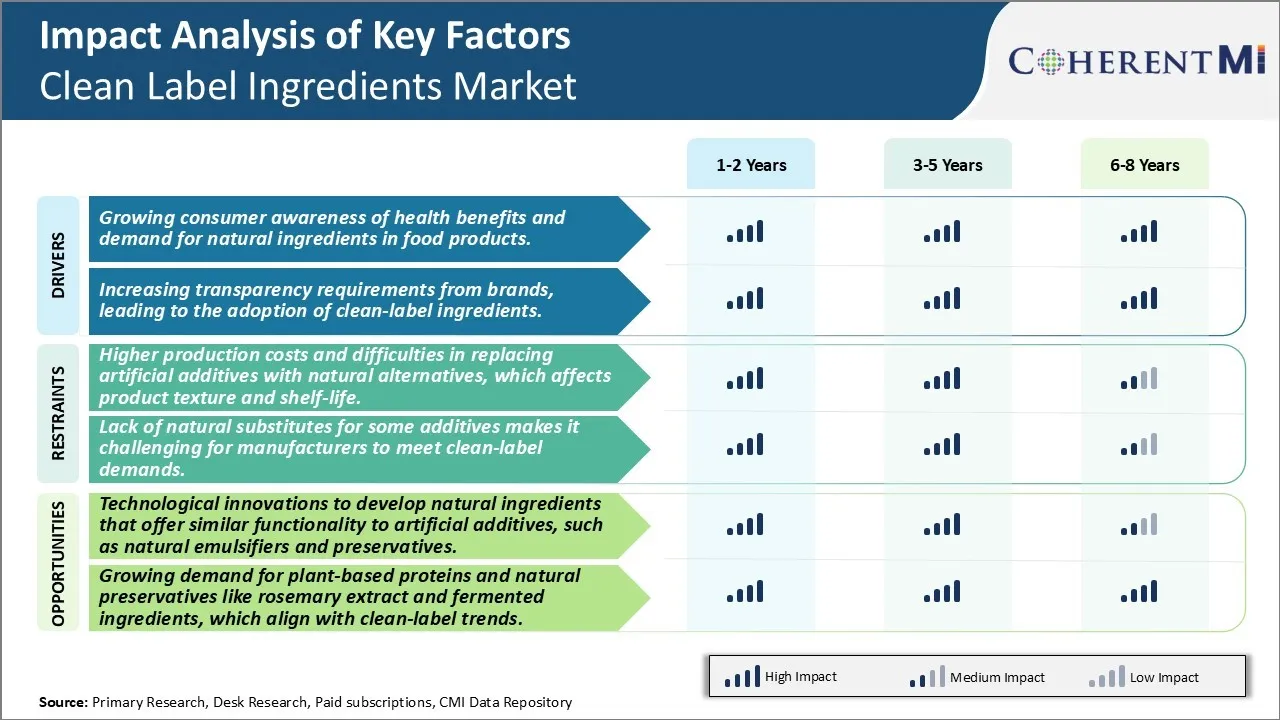Clean Label Ingredients Market Trends
Market Driver - Growing Consumer Awareness of Health Benefits and High Demand for Natural Ingredients in Food Products
Now-a-days consumers are showing increasing interest towards the ingredients used in their food products. With growing health consciousness and awareness about various illnesses caused due to intake of artificial ingredients, people are opting for products which contain all natural and clean label ingredients. There is an underlying apprehension about long term implications of consuming artificial preservatives, colors, flavors and other additives. Due to easy access to information through internet, consumers are more informed about what goes in their food and how different ingredients can impact their health. This is driving greater scrutiny of labels and fueling demand for foods made from natural, whole and simple ingredients that are familiar and easily understandable.
As consumers select products based on ingredients, many food companies are focusing on cleanness of their label by removing artificial ingredients from their products. Startups in particular are catering to this segment of health-conscious consumers by providing products made from natural ingredients along with their associated health benefits. Millennials especially are keen to pay premium prices for food and beverages that are devoid of artificial additives. Natural products are being perceived as more wholesome and nourishing options, offering nutrients in their purest form. Various surveys also indicate that consumer preference for clean label is here to stay long-term irrespective of economic cycles.
Market Driver - Increasing Transparency Requirements from Brands, Leading to the Adoption of Clean-Label Ingredients
With rising health and environment consciousness, regulatory agencies globally are imposing stricter norms of marketing and labelling processed food products. Brands are facing pressure to disclose complete ingredients list along with specifics about processing methods used. There is a push for simplified labels that can be effortlessly understood by general public instead of long scientific names that mean little to consumers. At the same time, bans or restrictions are being levied on certain artificial food additives and colors after assessing their health impact from long term usage. Nations are also collaborating to mutually recognize each other’s labelling laws to eliminate discrepancies faced by multinational brands.
Amid growing regulations, companies are proactively switching to clean label formulations. They are removing contested substances from top-selling products and modifying recipes to replace artificial inputs with natural alternatives. This ensures brands remain compliant while meeting consumer demands for clarity and purity. Firms are also resorting to minimal processing like lowering heat treatments or avoiding drying techniques that require preservatives. Some competitors are even highlighting their “clean label” positioning as a unique selling point to gain market share. With evolving standards, companies must now consider cleanness of label as an integral part of their innovation strategy going forward.
While overhauling recipes leads to short term costs, brands are able to charges lightly higher prices for their clean label offerings. Once consumers observe tangible benefits, they tend to pay the extra premium for the assurance of high-quality natural ingredients and peace of mind regarding contents. As transparency becomes an industry imperative, brands large and small will continue shifting towards clean label solutions to satisfy authorities and consumers as well as fortify their brand image for sustained long-term growth.

Market Challenge - Higher Production Costs and Difficulties in Replacing Artificial Additives with Natural Alternatives, Which Affects Product Texture and Shelf-Life
One of the key challenges facing the clean label ingredients market is the higher production costs associated with utilizing natural alternatives to artificial additives. Transitioning to natural ingredients often requires significant reformulation efforts to identify suitable plant-based or mineral substitutes that can adequately mimic the texture, flavor, and preservation attributes of synthetic options. This reformulation process is time-consuming and labor-intensive, increasing R&D expenses for food companies. Furthermore, natural additives are typically more expensive to source and produce at commercial scales compared to artificial chemicals. The difficulties in replicating the functionality of artificial ingredients also impacts production throughput. Transitioning product lines to clean labels may necessitate new equipment purchases or facility modifications to adjust production workflows. These increased costs are eventually passed on to consumers in the form of higher prices, which can impact demand growth. Clean label products also have more stringent quality and shelf-life requirements that are challenging to consistently meet with natural ingredients that have more variable compositions and properties compared to artificial additives. This affects product texture and stability over extended storage periods.
Market Opportunity: Technological Innovations to Develop Natural Ingredients That Offer Similar Functionality to Artificial Additives
A key opportunity for the growth of the clean label ingredients market lies in further technological innovations that facilitate the development of natural substitutes matching the attributes of artificial additives. Significant research investments are being made to identify plant-based formulations and processing methods to create clean label emulsifiers, preservatives, acidulants and other functional classes of ingredients. For example, novel extraction techniques and enzyme treatments are allowing for precise tailoring of natural polysaccharide compositions to achieve emulsification properties akin to synthetic emulsifiers. Likewise, combinations of natural antioxidants, antimicrobials and pH controllers are showing promise as shelf-life extending solutions with functionality on par with artificial preservatives. As the functionality gap between natural and artificial narrows, clean label products will become more seamlessly integrated into production lines with stable quality and shelf-life. This will accelerate mainstream adoption and drive significant market expansion.